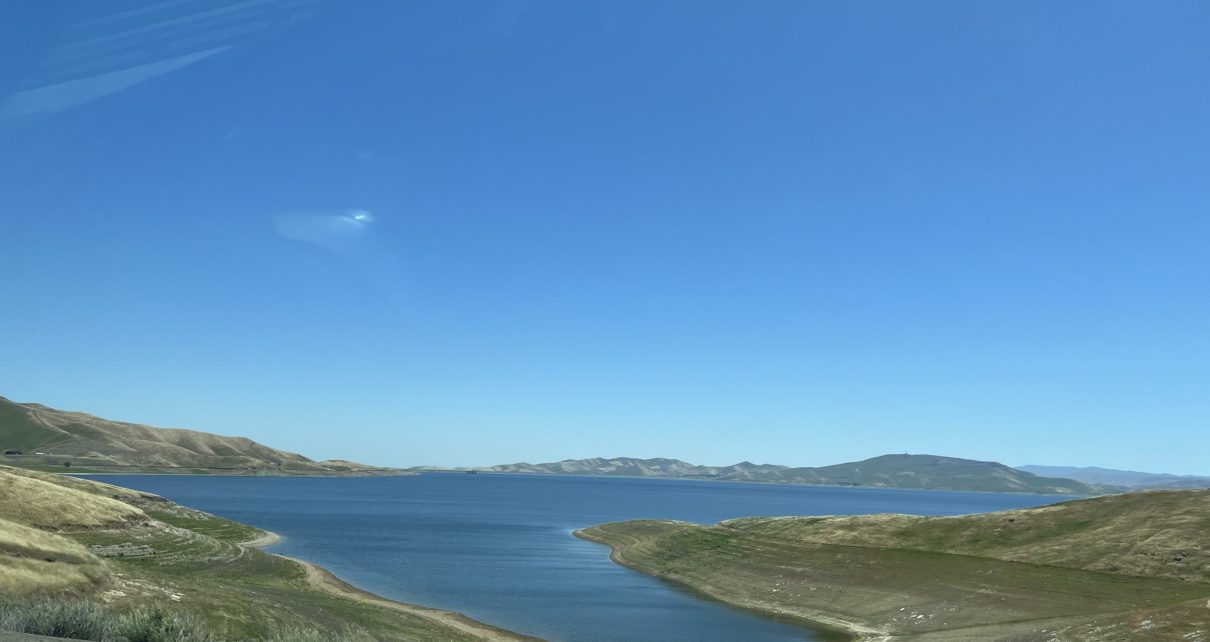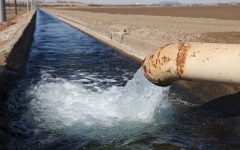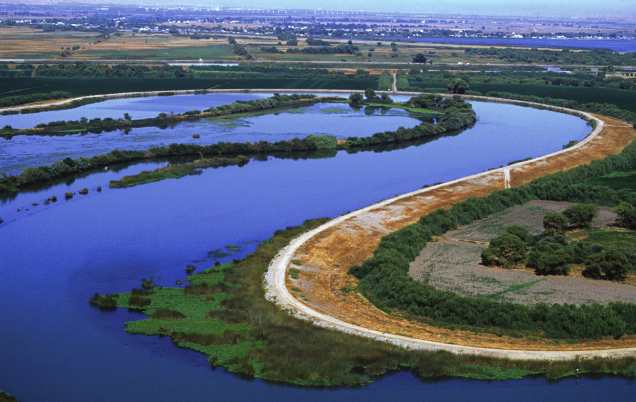
California San Luis Reservoir. (Photo: Katy Grimes for California Globe, April 2024)
Maddy Institute & California Water Institute FSU, Water Conference
Sending water out to sea in the fall since 2008 doesn’t help the smelt
By Don Wright, September 7, 2024 7:48 am
The Maddy Institute and the California Water Institute at Fresno State

University teamed up to host an event titled, “Exploring the Coexistence of Water Users in California” on Wednesday, September 4, 2024. The event ran from 8:30am to 3:00pm and included lunch provided by Wawona Frozen Foods. Panels included Moving and Storing Water, Demystifying Water Data, Ten Years of SGMA and Building Alliances Among Interest Groups for Holistic Solutions. The panels and speakers were All great stuff. But for many, me included, the biggest draw besides closing remarks by California Secretary of Agriculture Karen Ross, was the keynote address given by Wade Crowfoot, Secretary for Natural Resources. Lest we forget, there is a full court press by the San Joaquin Valley and Southern California to get the Fall X2 Line regulations changed or even removed.
The Fall X2 Line
When the tides are high and through Delta freshwater flows from the Sacramento and San Joaquin Rivers aren’t, salt water from the San Francisco Bay can make its way upstream. Before dams and the settling of the Delta salty water would make its way inland as far as the modern day locations of the Cities of Sacramento and Stockton during droughts. The Delta was alternately fresh and brackish. Now with dams operating under management guides fresh water can be released and push back the salt. The X2 line’s distance is measured from the Golden Gate upstream to the point where the bottom of the water column is found to have five parts per thousand salinity.
The purpose of the Fall X2 line regulation is to help the endangered Delta smelt. The idea is to push the salt water back to the bay by releasing freshwater flows to provide better conditions for smelt. There are two problems with this – it takes a large amount of water to flow against nature. That’s water that could be conveyed to the Valley and Southern California for beneficial uses like recharge, crops and homes and businesses. The other problem is after sending this water out to sea in the fall since 2008, according to studies by US Fish & Wildlife, it doesn’t help the smelt. There’s a good estimate that between 340,000 and 400,000 acre feet will be discharged into the Pacific Ocean this month for no other reason than that’s how we used to do it. This automatic flushing of our water reserves was based on the calendar and that is how it was done before adaptive management.
A Letter is Worth 1,000 Pictures
With improvements in monitoring and more understanding of the Delta’s biological rhythms, managing through Delta flows can be adapted to meet actual conditions. That’s adaptive management. Letters have been flying. On August 21st Westlands Water District, San Luis Delta Mendota Water Authority, the State Water Contractors and the Friant Water Authority sent a letter to US Bureau of Reclamation’s Regional Director Karl Stock and Karla Nemeth, Director of the state’s Department of Water Resources, asking them to adjust this year’s Fall X2 actions and offering to collaborate with them to implement adaptive management.
Also, on August 21st the Water Blueprint for the San Joaquin Valley and the Southern California Water Coalition sent a letter to Governor Gavin Newsom and the US Secretary of Interior Debra Haaland. It asked for the Fall X2 action to be suspended this year and adaptive management implemented.
In response on August 30th Nemeth, Paul Souza – Regional Director US Fish & Wildlife Service, Adam Nickels – Principal Deputy Regional Director US Bureau of Reclamation and Charlton Bonham – Director California Department of Fish & Wildlife sent a response letter addressed to Allison Febbo – General Manager Westlands Water District, Federico Barajas – Executive Director San Luis & Delta-Mendota Water Authority, Jennifer Pierre – General Manager State Water Contractors and Jason Phillips – Chief Executive Officer Friant Water Authority.
In this letter the government agencies told the water contractors they heard them. Here are some quotes, “As always, we take your input seriously and continue to reflect on it.”
It goes on, “The Department of Water Resources and U.S. Bureau of Reclamation, in partnership with the California Department of Fish and Wildlife (CDFW) and U.S. Fish and Wildlife Service (USFWS), are currently exploring a revised CVP and SWP fall 2024 operations plan that may include a modification of the Fall X2 action from its description in the 2019 USFWS Biological Opinion and the 2020 Incidental Take Permit issued by CDFW. We will work with you as we prepare the appropriate documentation and applications for this modification under federal and state law.” [Emphasis added]
Further in the letter, “We look forward to discussing with you how we anticipate actions such as Fall X2 will be handled through adaptive management in updated permits and biological opinions governing water project operations.”
The letter disputed the water contractors’ claims the Fall X2 action doesn’t benefit smelt, “The available science demonstrates that the Fall X2 action provides some important benefits to Delta smelt, such as increased food abundance and favorable water temperatures. The question of whether these benefits translate to more Delta smelt the following year has only recently been brought to light through a new USFWS life cycle model.”
Also disputed was the amount of water wasted by the Fall X2 action, “Your claim that the “water cost” of implementing the Fall X2 requirement in 2023 exceeded 730,000 acre-feet between the federal and state projects is not correct. We are available for further conversation about these estimates and wider project impacts.”
The letter ended, “We appreciate your concerns and look forward to more dialogue as we manage environmental and economic needs.”
Overall, a mixed bag. The government acknowledged a need to look at the current Fall X2 but didn’t come right out and state there will be any changes to this year’s actions.
Now they’ve done it. On the same day as the Water Conference another letter was sent. Twelve members of Congress wrote Stock, Souza and Jennifer Quan Regional Administrator, National Oceanic Atmospheric Administration Fisheries West Coast Region expressing concern how their respective federal agencies are handling their part in developing Long Term Operations for the Delta.
The letter states, “More importantly, at least some of these actions, such as the Fall X2 component of the Summer Fall Habitat Action, are not anticipated to have observable effects on species survival, yet they result in significant water supply reductions.” It was signed by Congressman David Valadao (CA-22), John Duarte (CA-13), Ken Calvert (CA-41), Jay Obernolte (CA-23), Darrell Issa (CA-48) Mike Garcia (CA-27), Doug LaMalfa (CA-01), Tom McClintock (CA-05), Michelle Steel (CA-45), Young Kim (CA-40), Vince Fong (CA-20), and Kevin Kiley (CA-03).
It appears everyone who is involved in either implementing the Fall X2 or being harmed by it are well aware this won’t be a routine action and many eyes are observing what takes place. Which makes the remarks from the Newsom Administration of particular interest.
Meanwhile Back at The Water Conference
At 10:00am Crowfoot addressed the conference for about 20 minutes and then took questions from the audience. His talk included desires to meet challenges brought by climate change and balancing groundwater while minimizing the economic impacts. He spoke about the need to provide clean, safe drinking water to everyone living in the state. Crowfoot said we can’t continue managing water with lawsuits and conflict. He cited adaptive management as preferable to the constant fighting over water – a statement that perked up many ears in the room.
Crowfoot also touched on how much taxpayer funded money the government is spending on infrastructure citing the state’s contribution to the repair costs of the federal Friant Kern Canal. I believe he said the state has spent $9 billion on water infrastructure in the past few years.
Crowfoot reports to Newsom directly and you can reasonably expect some positive light would be shed on the administration’s initiatives. The Delta Tunnel was mentioned and Crowfoot said 900,000 additional acre feet could have been conveyed if the tunnel was up and running during these wet years. He said the Voluntary Agreements has buy in from the State Water Resources Control Board as a way to improve water quality. If I understood correctly, he characterized the VAs as trading diversion reductions for more habitat.
The talked concluded with Crowfoot praising the Collaborative Action Program and the Water Blueprint for the San Joaquin Valley. He said California won’t be successful without the San Joaquin Valley being successful.
Q&A
Following Crowfoot’s talk Maddy Institute Executive Director Blake Zante invited folks to ask some questions. Lindsay Cederquist, Director of Water Resources for Maricopa Orchards was the first person to respond to Crowfoot.
“Farmers are exhausted,” said Cederquist. “Suspending the Fall X2 Management Action would be a step in the right direction to show collaboration and adaptive management.”
She pointed out the Fall X2 actions come at a time when every drop is needed for recharge to deal with the Sustainable Groundwater Management Act.
Crowfoot responded, “We need more adaptive management.” He said it could be only a matter of days to modify the X2 actions. I was fairly surprised that didn’t garner a round of applause.
Next Dr. Scott Hamilton told Crowfoot he was happy to hear the Newsom Administration’s response to Fall X2. He said after more than 15 years of studying the problem it was heartening to hear some progress can be made.
Crowfoot said the state needs to be more transparent and flexible. He reminded folks many of the requirements were ordered by a federal judge and hopes the Voluntary Agreements will give everyone a role to play in moving towards solutions in the Delta.
Hamilton asked what the Natural Resources Agency is doing to help meet the Valley’s infrastructure needs. Wisely, Crowfoot didn’t mention anything about investing in a railroad. Rather he referred to the money that has gone to the Friant Kern Canal repairs, land repurposing (that means fallowing or even retirement) and the Jobs First Program. He said there are 13 regional job plans for economic development. I’ve been told there is a lot of water baked into these plans.
Nat DiBuduo asked Crowfoot about the billions of dollars of proposition money set aside for storage infrastructure. He asked what good is it doing? He said when farms don’t get water land values drop and entire families and communities are hurting. It’s true there was a ballot passed in 2014 that dedicated more than $7 billion to amongst other things, increased surface storage. It’s about time to revisit that story and see where, if anywhere, that money has been used to increase water storage in California.
Crowfoot told DiBuduo the state, “Can’t paper over the challenges.” He said we have no control over nature but we do have control over regulations. While not directly replying to DiDuduo’s inference to the $2.7 billion in Prop One (Chapter 8) he pointed to the planned raising of the BF Sisk Dam on the San Luis Reservoir and the repairs to major conveyance arteries such as the Friant Kern Canal as examples of state investments. Crowfoot said SGMA will continue to have an impact and the state is working to ensure the proper infrastructure needed will be built. He repeated an axiom, agriculture in California will change, as it always has.
Zante and Laura Ramos, Interim Director of the California Water Institute presented Crowfoot with a gift basket full of treasures produced at Fresno State’s ag farm and Elvis left the building, as they say.
I walked Crowfoot to his car, which while black, wasn’t the black chauffeured Suburban with tinted windows I maybe might have expected. I think it was a Toyota sedan. Anyway. . .
There is a line in the August 30th letter sent by the government to the water contractors that read, “We will work with you as we prepare the appropriate documentation and applications for this modification under federal and state law.”
I asked Crowfoot if there is any need to take the X2 modifications through a court proceeding since the letter referenced the law and some of the requirements were court ordered. The timing is very important as the current, unmodified Fall X2 will take place this month, September 2024. A court hearing could drag on until next year.
Crowfoot said, “We don’t need to go to court [to modify the X2].”
That’s not to say there won’t be any legal wrangling taking place because of course, the usual enviro-law-firm Non-Governmental Organizations and neopagans seem to always be ready to sue. But if that happens it will be after the fact.
Crowfoot acknowledged it could look bad for the government to send 340,000 acre feet out to sea on the chance it might provide some uncertain benefit to the smelt during the age of SGMA. That was reassuring. By all measures, the folks on the government side are well aware of the situation and there is pressure to prevent sending water out to sea in the name of the Fall X2 without a good, provable reason.
I’ve been fortunate to get the opportunity to interact with Crowfoot at public events over the past few years. If I could read minds, I’d live in any zip code I wanted, but I can’t. I can however, say this, Crowfoot’s a likeable man, charming even. But those attributes can also give cause to be wary. However, every time I’ve met him, he’s been consistent and that’s an attribute worth paying attention to. I didn’t get any sense he was just saying what folks in the room wanted to hear. I believe the evidence is persuasive enough and hope Crowfoot will help champion a modification of the Fall X2. Lord knows this Valley needs the help.
To Comment on the federal side of the Delta operations:
Public Review and Comment Period: July 26, 2024 – September 9, 2024
Where to Review: The public draft EIS is available for public review via the following ways:
Project Website: https://www.usbr.gov/mp/nepa/nepa_project_details.php?Project_ID=54661
Comments due: Monday, September 9th
Contact: Tim Warner 916/539-9510 and sha-MPR-BDO@usbr.gov
- Jottings: California State Assembly Water, Parks & Wildlife Committee 4/29/2025 - April 30, 2025
- State Water Board’s Reckless Handing of the Sustainable Groundwater Management Act - March 4, 2025
- State Water Board Held Hearing Concerning Placing Kern Subbasin Under Probation, Part I - February 25, 2025








Don’t want to jinx anything, but it appears the administration and state agencies are inching toward something reasonable here. Fingers crossed.
Thank you very much for this report.
I’ve heard that one of the two people who could be President plans to have a commission led by Elon Musk audit Federal spending. I think anybody wasting that much water should expect to lose their job. Just a thought.